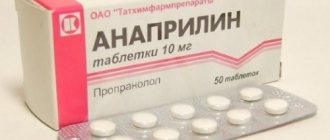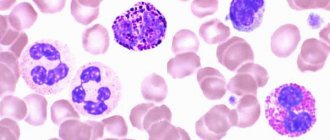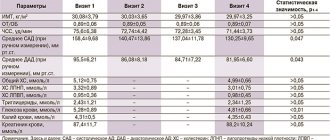Pharmacological properties of the drug Doxazosin
Selective postsynaptic blocker of α1-adrenergic receptors. Reduces peripheral vascular resistance, lowers blood pressure, has a beneficial effect on lipid metabolism, and with long-term use promotes regression of left ventricular hypertrophy. When taking doxazosin once a day, a clinically significant hypotensive effect persists for 24 hours. Blood pressure decreases gradually; the maximum effect is usually observed 2–6 hours after administration. In contrast to non-selective α-adrenergic receptor blockers, long-term treatment with doxazosin does not develop tolerance. During maintenance therapy, increased plasma renin activity and tachycardia are rarely detected. Taking doxazosin in patients with symptoms of benign prostatic hyperplasia (BPH) leads to a significant improvement in urodynamics and a decrease in the severity of symptoms of the disease. This effect is associated with selective blockade of α1-adrenergic receptors located in the stroma and capsule of the prostate gland and the bladder neck. Doxazosin is a strong blocker of α1A-adrenergic receptors, which constitute approximately 70% of all receptor subtypes found in the prostate gland. Doxazosin has no metabolic side effects and can be prescribed to patients with asthma, diabetes mellitus, gout, patients with left ventricular failure and the elderly. After oral administration in therapeutic doses, doxazosin is well absorbed; the maximum concentration in the blood is reached after approximately 2 hours. Most of doxazosin (98%) binds to plasma proteins. Elimination from blood plasma is biphasic, the half-life in the final phase is 22 hours, which allows it to be prescribed once a day. Doxazosin undergoes active biotransformation; less than 5% of the dose is excreted unchanged in the urine. In elderly people and patients with renal failure, the pharmacokinetics of doxazosin does not differ significantly from that in younger patients with normal renal function.
Doxazosin, 30 pcs., 4 mg, tablets
The frequency of adverse reactions is presented according to the following classification: very often - ≥10%; often - ≥1% and <10%; uncommon - ≥0.1% and <1%; rarely - ≥0.01% and <0.1%; very rare - <0.01%.
BPH
According to controlled clinical studies, patients with BPH experienced the same adverse reactions as patients with arterial hypertension.
The following adverse reactions have been reported during post-marketing use of the drug.
From the hematopoietic and lymphatic system:
very rarely - leukopenia, thrombocytopenia.
From the organ of hearing and vestibular apparatus:
infrequently - tinnitus.
From the side of the organ of vision:
often - impaired color perception; infrequently - atonic iris syndrome.
From the gastrointestinal tract:
often - abdominal pain, diarrhea, dyspepsia, dryness of the oral mucosa; infrequently - flatulence, constipation, vomiting.
From the liver:
very rarely - cholestasis, hepatitis, jaundice.
From the immune system:
very rarely - anaphylactic reactions.
Laboratory indicators:
infrequently - weight gain; very rarely - increased activity of liver transaminases.
From the side of metabolism:
infrequently - anorexia.
From the musculoskeletal system:
uncommon - arthralgia, back pain, muscle spasms, muscle weakness, myalgia.
From the central nervous system and peripheral nervous system:
often - paresthesia; infrequently - hypoesthesia, tremor.
From the mental side:
often - agitation, anxiety, insomnia; infrequently - depression.
From the urinary tract:
infrequently - increased frequency of urination, polyuria, urinary incontinence; very rarely - dysuria, hematuria, nocturia.
From the reproductive system:
very rarely - gynecomastia, impotence, priapism; very rarely - retrograde ejaculation.
From the respiratory system:
often - shortness of breath, rhinitis; infrequently - cough, nosebleeds; very rarely - exacerbation of existing bronchospasm.
From the skin:
uncommon - alopecia, itching, skin rash, purpura; very rarely - urticaria.
From the SSS side:
uncommon - flushing of the face, marked decrease in blood pressure, postural hypotension.
Other:
infrequently - pain of various localizations.
Arterial hypertension
In controlled clinical trials of Cardura, the most common adverse reactions were classified as postural (rarely associated with syncope) or non-specific, which included the following reactions.
From the organ of hearing and vestibular apparatus:
often - vertigo.
From the gastrointestinal tract:
often - nausea.
From the central nervous system and peripheral nervous system:
very often - dizziness, headache; often - postural dizziness (after taking the first dose, a pronounced decrease in blood pressure may develop, which can lead to orthostatic dizziness, in severe cases, especially when quickly moving from a lying position to a standing position or to a sitting position - to fainting), drowsiness.
From the respiratory system:
often - rhinitis.
Other:
often - asthenia, swelling of the lower extremities, fatigue, weakness.
The following adverse reactions were noted during the marketing use of the drug Cardura in patients with arterial hypertension, although in general such symptoms could be observed in the absence of treatment with this drug: often - tachycardia, palpitations, chest pain; infrequently - angina pectoris, myocardial infarction and arrhythmias; very rarely - bradycardia, cerebrovascular accident.
Use of the drug Doxazosin
Inside in the morning or evening. For hypertension (arterial hypertension) a daily dose of 1–16 mg is prescribed. Treatment begins with a dose of 1 mg once a day for 1–2 weeks. Over the next 1–2 weeks, the dose can be increased to 2 mg once a day. If necessary, the daily dose should be increased gradually, observing regular intervals, to 4, 8 and 16 mg, depending on the severity of the hypotensive effect. The usual dose is 2–4 mg once daily. For BPH, the initial dose of doxazosin is 1 mg once daily. Depending on the individual characteristics of urodynamics and the severity of the pathology, the dose can be increased to 2 mg, then to 4 mg and to the maximum recommended dose of 8 mg. The recommended interval for increasing the dose is 1–2 weeks. The usually recommended dose is 2–4 mg once a day. No dose adjustment of doxazosin is required in patients with renal failure. There is no experience with the use of doxazosin in children.
Doxazosin
special instructions
After taking doxazosin at the initial dose, orthostatic hypotension (first dose phenomenon) may develop, especially when standing. More often, this condition is observed in patients with hypovolemia, sodium deficiency, and in the elderly. In this regard, the initial dose is recommended to be taken before bedtime.
Doxazosin should be used with caution in elderly patients due to the possibility of orthostatic hypotension. As you age, your risk of dizziness, blurred vision and fainting increases.
The patient should be informed about the increased risk of orthostatic hypotension when drinking alcohol, standing or exercising for long periods of time, or in hot weather.
In patients with BPH, doxazosin can be prescribed both in the presence of arterial hypertension and in normal blood pressure. When used in patients with BPH with normal blood pressure, the change in the latter is not significant. At the same time, in patients with a combination of arterial hypertension and BPH, it can be used in monotherapy.
Before starting therapy for BPH, it is necessary to exclude its cancerous degeneration. Doxazosin does not affect the concentration of prostate-specific antigen (PSA) in blood plasma.
Caution must be exercised when prescribing doxazosin, as well as other drugs that are completely biotransformed in the liver, to patients with impaired liver function, avoiding prescribing maximum doses.
Intraoperative atonic iris syndrome. Intraoperative atonic iris syndrome (a variant of the “narrow pupil” syndrome) has been observed in some patients undergoing cataract surgery who are receiving or have received treatment with α1-blockers. It is necessary to warn the surgeon that the patient is currently taking α1-blockers or has previously taken them before surgery.
Priapism. Cases of the development of prolonged erection and priapism have been reported during therapy with α1-adrenergic receptors, incl. doxazosin. If an erection persists for more than 4 hours, you should immediately seek medical help. If treatment for priapism is not carried out immediately, it can lead to damage to the tissue of the penis and irreversible loss of potency.
There is no clinical experience with the use of doxazosin in children.
Impact on the ability to drive vehicles and operate machinery
At the beginning of therapy or when increasing the dose of doxazosin, a sharp decrease in blood pressure may occur, as a result of which dizziness may develop. In this regard, it is necessary to be careful when driving vehicles and working with complex technical devices that require increased concentration and speed of psychomotor reactions.
Doxazosin-fpo tab 2mg 30 pcs
Pharmacological group:
Alpha1-adrenergic blocker.
Pharmacodynamics:
Doxazosin is a selective competitive blocker of postsynaptic alpha1-adrenergic receptors (the affinity for alpha1-adrenergic receptors is 600 times higher than for alpha2-adrenergic receptors), reduces total peripheral vascular resistance (TPVR), prevents vasoconstriction caused by catecholamines, which ultimately leads to lowering blood pressure (BP) without developing reflex tachycardia.
Reduces pre- and afterload on the heart. After a single dose, the decrease in blood pressure develops gradually, the maximum decrease is observed after 2-6 hours and persists for 24 hours.
After a single dose of the drug, the maximum hypotensive effect is observed in the period from 2 to 6 hours, and in general the hypotensive effect persists for 24 hours. During treatment with doxazosin in patients with arterial hypertension (AH), there are no differences in blood pressure values in the “standing” and “lying” positions.
Effective for hypertension, including those accompanied by metabolic disorders (obesity, decreased glucose tolerance).
Reduces the risk of developing coronary heart disease (CHD). Taking the drug in patients with normal blood pressure is not accompanied by a decrease in blood pressure. With long-term use of doxazosin, patients develop tolerance.
During treatment with doxazosin, a decrease in the concentration of triglycerides and total cholesterol in the blood plasma is observed. At the same time, there is a slight (4-13%) increase in the high-density lipoprotein/total cholesterol ratio.
With long-term treatment with doxazosin, regression of left ventricular (LV) hypertrophy, suppression of platelet aggregation and an increase in the content of active plasminogen in tissues are observed.
Due to the fact that doxazosin blocks alpha1-adrenergic receptors located in the stroma and capsule of the prostate gland and in the neck of the bladder, there is a decrease in resistance and pressure in the urethra, and a decrease in the resistance of the internal sphincter. Therefore, the administration of doxazosin to patients with symptoms of benign prostatic hyperplasia (BPH) leads to a significant improvement in urodynamic parameters and a decrease in the manifestations of symptoms of the disease.
It has an effect in 66-71% of patients, the onset of action is after 1-2 weeks of treatment, maximum after 14 weeks, the effect lasts for a long time.
Pharmacokinetics:
After oral administration in therapeutic doses, doxazosin is well absorbed, absorption is 80-90% (simultaneous food intake slows down absorption by 1 hour), the time to reach the maximum concentration in the blood plasma (TCmax) is 3 hours, and when taken in the evening, TCmax extends to 5 hours.
Bioavailability – 60-70%. Communication with blood plasma proteins is about 98%. Elimination from blood plasma occurs in 2 phases, with a final half-life (T1/2) of 19-22 hours, which allows the drug to be administered once a day.
Intensively metabolized in the liver by o-demethylation and hydroxylation. In patients with impaired liver function, as well as when taking drugs that can alter hepatic metabolism, the biotransformation process of the drug may be disrupted. The main excretion is through the intestines (63-65% in the form of metabolites and about 5% unchanged). About 10% is excreted by the kidneys. A study of the pharmacokinetics of doxazosin in elderly patients and patients with kidney disease did not reveal significant pharmacokinetic differences.






